|
Enduring Treasures of the Shaker World
By Robert Reed
Posted March 2013
For the Shakers, they were always of two worlds. One contained their communities and the carefully crafted objects that were expressions of their faith. The other was the outside world.
"The same inner commitment that prompted the Believers to work hard was also responsible for the exceptional quality of their labor," observes William Kephart author of Extraordinary Groups, The Sociology of Unconventional Life-Styles. He adds, "Whether the product was a chair, a table, or a broom, the buyer could be assured of top workmanship."
In the beginning, the members of the religious sect, officially known as the United Society of Believers in Christ's Second Appearing, planned their own communities to be self-contained and have little to do with the outside world. During the early 1770s, the group broke with Quakers in England and settled in America. By 1776, in the midst of the American Revolution, the group formed a communal society based on the principles of equality and divine order in Watervliet, New York. Gradually, the movement grew and other communities were established.
In 1793, Peter Whitney wrote of the Shakers in Harvard, Massachusetts, "They are neat in apparel and furniture. Their houses, which they have erected in this town, are large and commodious and approaching something like elegance."
Early records show the Shakers, named for the dancing and shaking which was part of their very dedicated religious services, very readily adapted to crafting furniture for their own needs.
A member of the New Lebanon group wrote a thank-you note in 1807 for some well-needed lumber which was put to good group use. "Beloved Brother Peter," said the message, "we would inform you that we had a very nice table made of those black walnut boards which you sent by John Wright. We ate upon it the last Monday morning in November for the first time."
From time to time, especially in the early days, Shaker craftsmen were influenced by worldly styles, but for more than a half century, their furniture was simply beyond comparison.
"One factor contributing to the stylistic purity of the furniture (and other objects) made from the 1820s to the 1860s was that many of the cabinetmakers active during their period came into the Shaker families as children or young adults," noted Jerry Grant and Douglas Allen, authors of the distinguished book Shaker Furniture Makers.
By 1840, the Shaker movement had 4,000 to 6,000 members in 18 different communities from Maine westward to Ohio and Indiana. Individual communities were made up of 200 to 800 people who were then divided up into smaller families. Sisters did most of the household work and the sewing and weaving of goods, while brothers did most of the farming and making of furniture.
While goods were sometimes sold to the outside world, they were mainly constructed for use within the Shaker community. From chests of drawers to work stands, their skills and quality crafting knew no bounds.
Typically, the makers used available woods in plentiful supply. Often, this range included birch, butternut, cherry, maple and lots of pine and poplar. Some furniture was stained or painted in subdued hues of blue, green, red and yellow.;
The Shakers also fashioned and crafted a vast assortment of household goods, including oval boxes of various sizes for various uses, baskets, brooms, brushes, pails and wooden buckets. Eventually, they even made their own heavy metal wood-burning stoves.
The Shakers reached their peak in membership around the time of another major event in American history, the Civil War. But by 1875, the Believers were forced to advertise in area newspapers for members. It was also during this period that the Shakers began more extensive commercial activity with the "outside world."
Initially, they prospered by selling packaged seeds, herbs, ointments, brooms, baskets, and ladder-back chairs to the outsiders. Later, sales were elevated to sometimes include cupboards, desks and other substantial furniture. Because of the widespread knowledge of the Shaker crafting quality, the chairs, for example, became popular in households throughout the United States.
For various reasons, including strict celibacy, the Shaker movement had clearly waned during the early 20th century, and many of the sect's communities dwindled in members or disappeared altogether. During the 1920s, the Shakers and their wonderfully crafted wares were largely a forgotten phenomenon. Much of that changed, in part, due to the research and publishing efforts of Faith and Edward Andrews.
By 1929, House Beautiful magazine proclaimed that people fortunate to own something made by Shakers should "…preserve it with great care, for it will soon be considered an antique, and a rare one at that…. Now is the time to secure any pieces obtainable."
In recent years, the Skinner auction gallery in Boston offered an entire auction of Shaker artifacts. Making the sale standout was the fact that the material had been all purchased directly from Shakers by a single collector. Long decades ago, this person heard that some surviving Shakers still lived at Canterbury. Upon going there, the visitor was welcomed at the door by a cheerful Sister.
Some items were available in their small “antique” shop located in the Shaker schoolhouse. So began what ultimately became a major holding of Shaker material.
The unidentified owner obtained the Shaker items from the 1940s through the 1960s, mainly at the Canterbury settlement in New Hampshire. They were used to entirely furnish a Shaker house converted into a private home. Among the many prized items were: a one-door cupboard made at the Sabbath Day Lake settlement in Maine during the 1790s; a tall two-door Shaker cupboard crafted around 1800; and a three-drawer blanket box with red-orange paint from the 1840s.
Experts note that furnishings with the original staining or painting intact are highly valued. Many times, Shaker objects were marked with the name of the particular community and sometimes the name of the user or the maker. It is sometimes difficult to specifically date Shaker furnishings since many followed the same simple design and traditional construction from the 1830s and 1840s on through the latter part of the 19th century.
Ironically, their religious beliefs and stern lifestyle did not endure much beyond the dawn of the 20th century, but the objects of their crafting are known worldwide.
"In the end, it is for their architecture and finely crafted furnishings that we remember the Shakers best," concludes Rebecca Sawyer-Fay in the appealing book Living With Folk Art. "The Shaker eye for order and balance yielded buildings of near perfect symmetry, while capable hands turned out austerely beautiful quilts, rugs, and furniture with a grace of line and purity of form that has proved timeless."
|
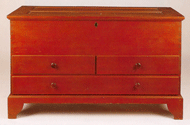
A pine three-drawer Shaker blanket box, ca. 1848, New Hampshire.
(Photo: Skinner Auctions.)
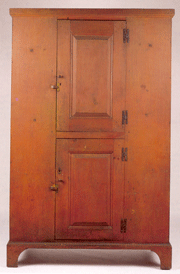
Tall two-door Shaker pine cupboard, ca. 1800, Mount Lebanon, N.Y.
(Photo: Skinner Auctions.)
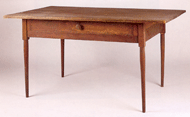
One-drawer Shaker table, ca. 1850, Canterbury, N.H.
(Photo: Skinner Auctions)
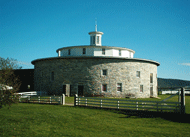
A round barn at Hancock Shaker Village, Pittsfield, Mass.
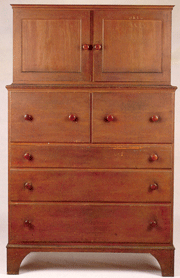
|